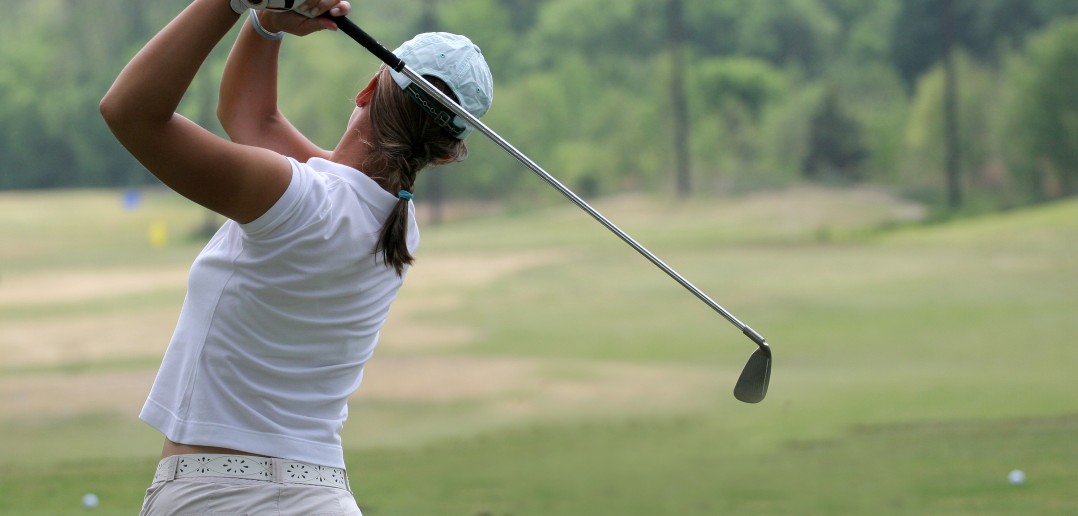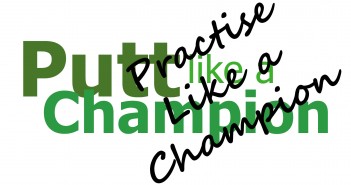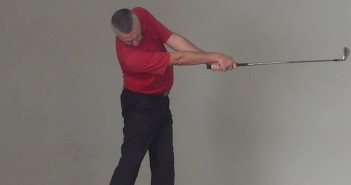Practice does not make perfect. Only perfect practice makes perfect.
This quote from Vince Lombardi has become a bit of a cliché, but it’s one of the most important messages you’ll ever hear with regard to improving your golf swing.
Most amateurs haven’t got a clue how to practise most effectively – from the moment they first picked up a golf club and whiffed at the ball, their game has been a succession of quick fixes, hours spent on the range pounding balls, maybe the odd lesson, constantly looking for “it”. Perhaps they find “it” for a day, but they’re never quite sure what “it” was or where it came from, and a week later they’re floundering again. From day 1, their instinctive effort to swing the club with their shoulders and arms, and control it with their hands, set them on completely the wrong path, and every swing they have made since then has only served to ingrain bad habits.
No matter how hard they work on their game, they never improve as much as they’d hoped they would. “I know I can be really good at this game, I just need to find that one thing…”
The Swing like a Champion system changes all that. It gives you a structured learning system, based on science, that offers you the fastest way possible to improve your golf swing.
Not only that, but the roadmap that Golf Loopy gives you will enable you to be your own coach, to identify the areas where you can gain most benefit, to self-diagnose your faults and quickly get back on track when you’re struggling, and to keep improving for the rest of your golfing life.
This article explains how our most successful students use the system for optimal, rapid results.
Follow the Programme
The Swing like a Champion system is designed to maximise your progress. Follow the drills in the order given in the table of contents. Don’t be tempted to skip ahead, you will hinder your progress.
Read and digest the introduction to the system, read and re-read the instructional articles and drill descriptions. You need to understand the process and “buy in” to it, and you need to learn how to coach yourself.
But reading isn’t enough. Get up and move! As you are reading the drills, stand up occasionally and make the movements being described – associate the understanding with the feeling. Once you understand how to work on the drill, you can start including it in your regular drill sessions.
Short, Focussed Sessions
Deliberate Practice must be really hard work!
To make optimal use of your time, you must have laser focus. You must be aggressively concentrating on one thing, no distractions, no room in your brain for anything else. It must be a struggle if it’s going to work.
You may be able to focus on complex issues at work for hours at a time, but if you’re not mentally fatigued after 10 minutes of deliberate practice, then you’re doing it wrong.
For the best possible progress, we’d recommend three 10 minute sessions per day, six days per week. Some students are capable of more, but they are rare. Quality over quantity, every time! You can still make great progress with just one 5 minute session per day, it’ll just take a little longer.
In each session, plan to work on only one movement. Yes, at the beginning of a session working on, say, the takeaway, you should do your posture and stance checks to make sure no bad habits are creeping in, but the aim of the session will be to focus on one part of the golf swing movement, only one drill per session to begin with, then blending drills together as you progress. Do all of your reading in advance so that you know exactly what you will be working on, and how to do it. Keep a practice journal, as described in Accountability to the Plan.
If you are finding the planned drill too difficult, you may need to step back and work on an earlier drill. Similarly, if you identify a problem with your posture or setup, stop and work on that instead.
The real “progress” happens when you are resting in between sessions, and mostly while you sleep. Learning new motor patterns is a biological process, you are “growing” new and stronger pathways in your brain. That growth is triggered by your fierce determination and focus during the drill session, telling your subconscious mind that this new skill is important. If your session has too many elements then the messages to your subconscious will be confused and the growth won’t happen, your progress will be hindered.
Love Your Mistakes
Detecting and correcting errors in your movements is the best way to improve, by far!
To do that you need to make mistakes. You should be working close to your limit. Ideally, you will be able to perform the drill perfectly 4 out of 5 times – you’re certainly not floundering, but you are making mistakes. This is the learning “sweet spot”.
You will also need feedback. Always work in front of a mirror, and use video as often as you can. You must have a mechanism for detecting your mistakes as they happen.
Be vigilant for the slightest error. Get excited when you find one: “Oooo that’s interesting! Where did that come from?!”
As you become more competent, delay the immediate feedback from the mirror by performing the drill with your eyes closed. Pause to estimate your error before looking in the mirror to see if what you expected is what actually happened. Correct the position, how does that feel different to the reality? And try again.
Video feedback is very powerful, but try and watch the video as soon as possible after you perform the movement, analyse it, then try again.
Perform each drill in slow motion at first, then as you get better at it build up speed to stay within the “4 in 5” zone.
Constant struggle, constant feedback, constantly finding and correcting mistakes – the drill must be “keeping you on your toes”. Every session should be a challenge. “Hey, subconscious, pay attention, this is important dammit!”
With each error corrected, and with each small step up in the speed and fluidity that you are able to move without error, you are building trust, your subconscious is taking “ownership” of the movement. The whole purpose of these drills is that, eventually, you will be able to perform the correct movements out on the golf course without thinking about it – your subconscious athlete, The Player, will be in the driving seat.
Exaggerate
Feel is not real. We can’t stress this strongly enough. Feeling like they are moving correctly is the #1 reason golfers don’t improve. That’s why you need feedback, you can’t trust your feelings, your proprioception, until you have educated them.
When you notice that you are making a particular mistake, start to correct it by exaggerating the correction. For example, if you are bringing the club too far inside in the takeaway, work on “feeling like” you are keeping the club too far outside.
A small change will usually feel huge! You might feel like the movement is massively exaggerated, but when you watch yourself on video it won’t be – you may not even be doing it enough!
If you think you’re doing it enough, it’s never nearly enough!
Over time, as you improve and ingrain the movements, these feelings will change, and you’ll need to gradually tone them down. Once you’re used to a thing, it will feel right, and the exaggerated feeling you worked on earlier will no longer be valid.
Feel will always be misleading. You need to validate it, adjust it, constantly test it during your drill sessions.
You will also need to check your basics on a regular basis. The best players in the world check their setup every week, so should you. Mistakes, especially old bad habits, will creep back in very quickly if you allow them to, and you won’t even notice – your feelings can’t be trusted!
Progression
The drills start very simply, with small movements. You are building solid foundations, ingraining the basics that will support a truly great golf swing.
The system builds the movements up, piece by piece, starting with isolated movements, without a golf ball, a golf club, even without moving your arms. Over time, the drill progress and you’ll be swinging a club and hitting balls, but only when the foundations have had time to “set”. Even then, you’ll start by making small, slow swings.
After a few sessions on each drill your focus will move on to the next, and eventually you will start blending the movements together, “stacking” them into increasingly complex movements.
Don’t rush the process. Your brain needs time to ingrain the basics, to grow those neural pathways. Slow and steady wins this race.
You can’t learn the golf swing at full speed, your brain doesn’t work that way!
Repetition
To ingrain a new or changed movement pattern takes time and it takes repetition.
As a rule, it will take about 3,000 repetitions of a single movement before it’s ingrained enough to rely on it, before The Player can perform the movement efficiently and consistently.
But reps aren’t everything. 100 really good, highly focussed and vigilant repetitions are worth more than 1000 mindless repetitions.
Try to get 100 really good reps in each day. So, if you’re working in the “4 in 5” sweet spot, then you’ll need to attempt the movement 40 times during each session, three times per day.
Playing Golf
We want you to “love your mistakes”, to make lots of them and learn from each and every one. This is the path to accelerated learning. But it’s really difficult, impossible, to love mishitting the ball!
This is another good reason for working in the way that we do. As soon as you have a golf ball in front of you, it will consume your focus, you’ll be fixated. Your concentration, your ability to learn, will also suffer because trying to hit a golf ball with a new movement will immediately trigger a fear response, and the anxiety that you feel will hinder your progress.
The drills are designed to enable you to work in a safe, focussed way that tells your subconscious that what you are doing is important to you, that your brain should make an effort to “grow” the skill as quickly as possible.
When you mishit balls, your anxious subconscious mind will respond by screaming “What the hell are you trying to do to me! I can’t hit balls like that! No way I’m learning that for you, I’m outa here!”
There’s no doubt that you would learn faster if you stayed away from golf balls, at least to begin with. But there’s no way we could recommend that you stop playing this wonderful game!
So, when you do go out and play, don’t practice. Don’t think about your new swing. Enjoy the company, the scenery, have fun!
Your swing is changing, your subconscious will already be integrating the new movement patterns into your swing, and you’ll make mistakes. Laugh them off, smile and move on, they’re a sure sign that things are changing, that you’re getting better.
Don’t let your subconscious learn to fear the changes. Do not, as far as humanly possible, let yourself have an emotional response to a bad shot.
Perform an extra drill session after every round of golf. Swinging a golf club is the fastest way to reassert your bad habits, and you’ll need to compensate for that with a little extra work.
Try and avoid the driving range until you’re confident enough with your movements to practise hitting balls. When you do take it to the range, make small swings at first, hitting the ball just a few yards – quality not quantity. Stay in the “4 in 5” sweet spot.
We don’t want you to miss out on enjoying your golf, but going out and hitting balls unnecessarily will only reinforce your bad habits and hinder your progress.
The 8-Week Programme
The Golf Loopy 8 Weeks to a Great Golf Swing programme is a step-by-step, session-by-session guide that will walk you through the whole process, transforming your golf swing in just 8 weeks.
The programme is detailed, but is designed to be flexible, so that you can adjust it to your own needs and optimise your own progress.
Throughout the programme, and beyond, you will never stop working on the basics, on your posture, address position and takeaway – it’s so easy for faults to creep in unnoticed when your focus is on other parts of the swing. The basics need to be near-perfect if they are to support a great golf swing, so they need continual monitoring and maintenance.
When you sharpen a basic skill, everything you do with that skill improves automatically.
The 8-week programme is a feel-based system that guides you through the drills, in roughly the order listed in the table of contents, using the techniques we’ve described here, and helps you to gradually integrate the swing changes into your game.
Your golf swing will improve immediately and significantly – the system is proven to quickly cut amateurs’ handicaps in half, it has helped thousands of golfers to achieve single-digit handicaps, and many have already progressed to elite-level “better-than-scratch” plus-handicap performance.
So, what are you waiting for? Join us today and start playing the best golf of your life!
You May Also Like…
Introduction to the Swing like a Champion System.
Overview of a Great Golf Swing, which summarises the correct movements in a great golf swing.
How to Use the Full Swing System.




